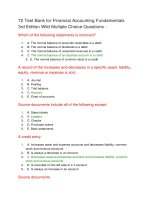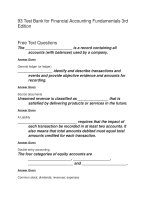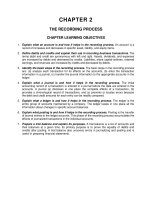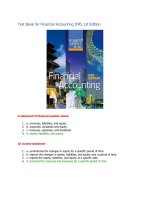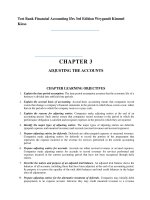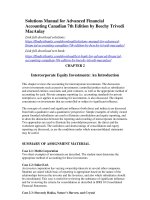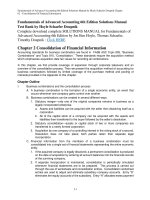Financial accounting IFRS 3rd edition solutions manual
Bạn đang xem bản rút gọn của tài liệu. Xem và tải ngay bản đầy đủ của tài liệu tại đây (774.61 KB, 52 trang )
Financial Accounting IFRS 3rd Edition Solutions Manual Weygandt Kimmel
Kieso
CHAPTER 3
Adjusting the Accounts
ASSIGNMENT CLASSIFICATION TABLE
Learning Objectives
Questions
*1.
Explain the time period
assumption.
*2.
Brief
Exercises
A
Problems
B
Problems
5, 6, 7, 8, 9,
10, 11, 12,
13, 15
1A, 2A, 3A,
4A, 5A, 6A
1B, 2B, 3B,
4B, 5B
3
5, 6, 7, 8,
9, 10, 11,
12, 13, 15
1A, 2A, 3A,
4A, 5A, 6A
1B, 2B, 3B,
4B, 5B
4
10, 11, 12,
1A, 2A, 3A,
1B, 2B, 3B,
Do It!
Exercises
1
1
1
Explain the accrual basis
of accounting.
2, 3, 4, 5
1
2, 3, 10,16
*3.
Explain the reasons for
adjusting entries.
6, 7
1
*4.
Identify the major types
of adjusting entries.
8, 18
2, 8
*5.
Prepare adjusting
entries for deferrals.
8, 9, 10, 11,
12, 13, 18,
19, 20
2, 3, 4, 5,
6, 8
2
*6.
Prepare adjusting
entries for accruals.
8, 14, 15,
16, 17, 18,
19, 20
2, 7, 8
*7.
Describe the nature and
21
9, 10
Weygandt Financial Accounting IFRS 3e Solutions Manual
4, 6, 11
3-1
purpose of an adjusted
trial balance.
13, 14
5A, 6A
6A
*8.
Prepare adjusting
entries for the alternative
treatment of deferrals.
22
11
17, 18
*9.
Discuss financial
reporting concepts.
23, 24, 25,
26, 27, 28
12, 13
14, 15
19, 20, 21,
22, 23
5B
*Note: All asterisked Questions, Exercises, and Problems relate to material contained in the appendix to the
chapter.
Weygandt Financial Accounting IFRS 3e Solutions Manual
3-2
ASSIGNMENT CHARACTERISTICS TABLE
Problem
Number
Description
Difficulty
Level
Time
Allotted (min.)
1A
Prepare adjusting entries, post to ledger accounts,
and prepare an adjusted trial balance.
Simple
40–50
2A
Prepare adjusting entries, post, and prepare adjusted
trial balance and financial statements.
Simple
50–60
3A
Prepare adjusting entries and financial statements.
Moderate
40–50
4A
Prepare adjusting entries.
Moderate
30–40
5A
Journalize transactions and follow through accounting
cycle to preparation of financial statements.
Moderate
60–70
Prepare adjusting entries, adjusted trial balance,
and financial statements using appendix.
Moderate
40–50
*6A*
1B
Prepare adjusting entries, post to ledger accounts,
and prepare an adjusted trial balance.
Simple
40–50
2B
Prepare adjusting entries, post, and prepare adjusted
trial balance and financial statements.
Simple
50–60
3B
Prepare adjusting entries and financial statements.
Moderate
40–50
4B
Prepare adjusting entries.
Moderate
30–40
5B
Journalize transactions and follow through accounting
cycle to preparation of financial statements.
Moderate
60–70
Weygandt Financial Accounting IFRS 3e Solutions Manual
3-3
WEYGANDT FINANCIAL ACCOUNTING, IFRS EDITION, 3e
CHAPTER 3
ADJUSTING THE ACCOUNTS
Number
LO
BT
Difficulty
Time (min.)
BE1
3
C
Simple
4–6
BE2
4–6
AN
Moderate
6–8
BE3
5
AN
Simple
3–5
BE4
5
AN
Simple
3–5
BE5
5
AN
Simple
2–4
BE6
5
AN
Simple
2–4
BE7
6
AN
Simple
4–6
BE8
4–6
AN
Simple
5–7
BE9
7
AP
Simple
4–6
BE10
7
AP
Simple
2–4
BE11*
8
AN
Moderate
3–5
BE12*
9
K
Simple
3–5
BE13*
9
K
Simple
2–4
BE14*
9
K
Simple
2–4
BE15*
9
K
Simple
1–2
DI1
1, 2
K
Simple
2–4
DI2
5
AN
Simple
6–8
DI3
6
AN
Simple
4–6
DI4
7
AN
Moderate
20–30
EX1
1
C
Simple
3–5
EX2
2
E
Moderate
10–15
EX3
2
AP
Simple
6–8
EX4
4
AN
Simple
5–6
EX5
5, 6
AN
Moderate
10–15
EX6
4–6
AN
Moderate
10–12
EX7
5, 6
AN
Moderate
8–10
EX8
5, 6
AN
Moderate
8–10
EX9
5, 6
AN
Simple
8–10
EX10
2, 5–7
AN
Moderate
8–10
EX11
4–7
AN
Moderate
12–15
EX12
5–7
AN
Moderate
8–10
Weygandt Financial Accounting IFRS 3e Solutions Manual
3-4
ADJUSTING THE ACCOUNTS (Continued)
Number
LO
BT
Difficulty
EX13
5–7
AN
Simple
8–10
EX14
7
AP
Simple
12–15
EX15
5, 6
AN, S
Moderate
8–10
EX16
2
AN
Moderate
8–10
EX17*
8
AN
Moderate
6–8
EX18*
8
AN
Moderate
10–12
EX19*
9
K
Simple
3–5
EX20*
9
C
Simple
3–5
EX21*
9
K
Simple
6–8
EX22*
9
E
Simple
10–20
EX23*
9
E
Simple
10–20
P1A
5–7
AN
Simple
40–50
P2A
5–7
AN
Simple
50–60
P3A
5–7
AN
Moderate
40–50
P4A
5, 6
AN
Moderate
30–40
P5A
5–7
AN
Moderate
60–70
P6A
5–8
AN
Moderate
40–50
P1B
5–7
AN
Simple
40–50
P2B
5–7
AN
Simple
50–60
P3B
5–7
AN
Moderate
40–50
P4B
5, 6
AN
Moderate
30–40
P5B
5–7
AN
Moderate
60–70
BYP1
5, 6
AN
Simple
10–15
BYP2
—
AN
Simple
10–15
BYP3
2–7
S
Moderate
15–20
BYP4
3–6
C
Simple
10–15
BYP5
3–6
E
Moderate
10–15
Weygandt Financial Accounting IFRS 3e Solutions Manual
3-5
Time (min.)
Correlation Chart between Bloom’s Taxonomy, Learning Objectives and End-of-Chapter Exercises and Problems
Knowledge
Comprehension
Application
Analysis
Synthesis
*1.
Explain the time period assumption.
DI3-1
Q3-1
E3-1
*2.
Explain the accrual basis of accounting.
DI3-1
Q3-2
Q3-3
Q3-4 Q3-5
E3-3
*3.
Explain the reasons for adjusting entries.
Q3-6
Q3-7
BE3-1
*4.
Identify the major types of adjusting entries.
Q3-8
Q3-18
BE3-2
BE3-8
E3-4
E3-6
E3-11
*5.
Prepare adjusting entries for deferrals.
Q3-8
Q3-9
Q3-10
Q3-11
Q3-12
Q3-13
Q3-19
Q3-20
Q3-18
BE3-2
BE3-3
BE3-4
BE3-5
BE3-6
BE3-8
DI3-2
E3-5
E3-6
E3-7
E3-8
E3-9
E3-10
E3-11
E3-12
E3-13
E3-15
P3-1A
P3-2A
P3-3A E3-15
P3-4A
P3-5A
P3-6A
P3-1B
P3-2B
P3-3B
P3-4B
P3-5B
*6.
Prepare adjusting entries for accruals.
Q3-8
Q3-14
Q3-15
Q3-19
Q3-20
Q3-17
Q3-16
Q3-18
BE3-2
BE3-7
BE3-8
DI3-3
E3-5
E3-6
E3-7
E3-8
E3-9
E3-10
E3-11
E3-12
E3-13
E3-15
P3-1A
P3-2A
P3-3A
P3-4A E3-15
P3-5A
P3-6A
P3-1B
P3-2B
P3-3B
P3-4B
P3-5B
*7.
Describe the nature and purpose of an
adjusted trial balance.
Q3-21
BE3-9
BE3-10
E3-14
DI3-4
E3-10
E3-11
E3-12
E3-13
P3-1A
P3-2A
P3-3A
P3-5A
P3-6A
P3-1B
P3-2B
P3-3B
P3-5B
*8.
Prepare adjusting entries for the alternative
treatment of deferrals.
Q3-22
BE3-11
E3-17
*9.
Discuss financial reporting concepts
Broadening Your Perspective
Q3-23
BE3-12
BE3-13
BE3-14
BE3-15
E3-19
E3-21
Q3-24
Q3-25
Q3-26
Q3-27
Q3-28
E3-20
Communication
E3-10
E3-16
Evaluation
E3-2
E3-18
P3-6A
E3-22
E3-23
Financial Reporting
Decision-Making Ethics Case
Comparative Analysis Across the
Organization
BLOOM’S TAXONOMY TABLE
Learning Objective
ANSWERS TO QUESTIONS
1.
(a) Under the time period assumption, an accountant is required to determine the relevance of
each business transaction to specific accounting periods.
(b) An accounting time period of one year in length is referred to as a fiscal year. A fiscal year
that extends from January 1 to December 31 is referred to as a calendar year. Accounting
periods of less than one year are called interim periods.
LO: 3.1
Difficulty: Easy
BLOOMCODE: Comprehension
AACSB: Reflective thinking
2.
The two principles that relate to adjusting the accounts are:
The revenue recognition principle, which states that revenue should be recognized in the accounting
period in which the performance obligation is satisfied.
The expense recognition principle, which states that efforts (expenses) should be matched with
accomplishments (revenues).
LO: 3.2
Difficulty: Easy
BLOOMCODE: Comprehension
AACSB: Reflective thinking
3.
The law firm should recognize the revenue in April. When a company agrees to perform a service
for a customer it has a performance obligation. The revenue recognition principle states that
revenue should be recognized in the accounting period in which the performance obligation is
satisfied which is April in this case.
LO: 3.2
Difficulty: Easy
BLOOMCODE: Comprehension
AACSB: Reflective thinking
4.
Information presented on an accrual basis is more useful than on a cash basis because it reveals
relationships that are likely to be important in predicting future results. To illustrate, under accrual
accounting, revenues are recognized when earned so they can be related to the economic
environment in which they occur. Trends in revenues are thus more meaningful.
LO: 3.2
Difficulty: Easy
BLOOMCODE: Comprehension
AACSB: Reflective thinking
5.
Expenses of £4,700 should be deducted from the revenues in April. Under the expense
recognition principle efforts (expenses) should be matched with accomplishments (revenues).
LO: 3.1
Difficulty: Easy
BLOOMCODE: Application
AACSB: Reflective thinking
Weygandt Financial Accounting IFRS 3e Solutions Manual
3-7
6.
No, adjusting entries are required by the revenue recognition and expense recognition principles.
LO: 3.3
Difficulty: Easy
BLOOMCODE: Comprehension
AACSB: Reflective thinking
7.
A trial balance may not contain up-to-date information for financial statements because:
(1) Some events are not journalized daily because it is not efficient to do so.
(2) The expiration of some costs occurs with the passage of time rather than as a result of daily
transactions.
(3) Some items may be unrecorded because the transaction data are not yet known.
LO: 3.3
Difficulty: Easy
BLOOMCODE: Comprehension
AACSB: Reflective thinking
8.
The two categories of adjusting entries are deferrals and accruals. Deferrals consist of prepaid
expenses and unearned revenues. Accruals consist of accrued revenues and accrued expenses.
LO: 3.5, 3.6
Difficulty: Easy
BLOOMCODE: Comprehension
AACSB: Reflective thinking
9.
In the adjusting entry for a prepaid expense, an expense is debited and an asset is credited.
LO: 3.5
Difficulty: Easy
BLOOMCODE: Comprehension
AACSB: Reflective thinking
10.
No. Depreciation is the process of allocating the cost of an asset to expense over its useful life in
a rational and systematic manner. Depreciation results in the presentation of the book value of
the asset, not its fair value.
LO: 3.5
Difficulty: Easy
BLOOMCODE: Comprehension
AACSB: Reflective thinking
11.
Depreciation expense is an expense account whose normal balance is a debit. This account
shows the cost that has expired during the current accounting period. Accumulated depreciation
is a contra asset account whose normal balance is a credit. The balance in this account is the
depreciation that has been recognized from the date of acquisition to the statement of financial
position date.
LO: 3.5
Difficulty: Easy
BLOOMCODE: Comprehension
AACSB: Reflective thinking
Weygandt Financial Accounting IFRS 3e Solutions Manual
3-8
Questions Chapter 3 (Continued)
12.
Equipment .................................................................................. Rs 18,000,000
Less: Accumulated Depreciation—Equipment .....................................
7,000,000
Rs 11,000,000
LO: 3.5
Difficulty: Easy
BLOOMCODE: Comprehension
AACSB: Reflective thinking
*13.
In the adjusting entry for an unearned revenue, a liability is debited and a revenue is credited.
LO: 3.5
Difficulty: Easy
BLOOMCODE: Comprehension
AACSB: Reflective thinking
*14.
Asset and revenue. An asset would be debited and a revenue would be credited.
LO: 3.6
Difficulty: Easy
BLOOMCODE: Comprehension
AACSB: Reflective thinking
*15.
An expense is debited and a liability is credited in the adjusting entry.
LO: 3.1
Difficulty: Easy
BLOOMCODE: Comprehension
AACSB: Reflective thinking
*16.
Net income was understated NT$6,000 because prior to adjustment, revenues are understated
by NT$27,000 and expenses are understated by NT$21,000. The difference in this case is
NT$6,000 (NT$27,000 – NT$21,000).
LO: 3.6
Difficulty: Medium
BLOOMCODE: Analysis
AACSB: Analytic
*17.
The entry is:
Jan. Error! Reference source not found.9 ... Salaries and Wages Payable
Salaries and Wages Expense ......................................................
Cash .....................................................................................
2,000
4,000
LO: 3.6
Difficulty: Easy
BLOOMCODE: Application
AACSB: Reflective thinking
*18.
(a) Accrued revenues.
(b) Unearned revenues.
(c) Accrued expenses.
Weygandt Financial Accounting IFRS 3e Solutions Manual
(d) Accrued expenses or prepaid expenses.
(e) Prepaid expenses.
(f) Accrued revenues or unearned revenues.
3-9
6,000
LO: 3.6
Difficulty: Medium
BLOOMCODE: Analysis
AACSB: Analytic
*19.
(a) Salaries and Wages Payable.
(b) Accumulated Depreciation.
(c) Interest Expense.
(d) Supplies Expense.
(e) Service Revenue.
(f) Service Revenue.
LO: 3.5, 3.6
Difficulty: Easy
BLOOMCODE: Comprehension
AACSB: Reflective thinking
*20.
Disagree. An adjusting entry affects only one statement of financial position account and one
income statement account.
LO: 3.5, 3.6
Difficulty: Easy
BLOOMCODE: Comprehension
AACSB: Reflective thinking
*21.
Financial statements can be prepared from an adjusted trial balance because the balances of
all accounts have been adjusted to show the effects of all financial events that have occurred
during the accounting period.
LO: 3.7
Difficulty: Easy
BLOOMCODE: Comprehension
AACSB: Reflective thinking
*22.
For Supplies Expense (prepaid expense): expenses are overstated and assets are understated.
The adjusting entry is:
Assets (Supplies)......................................................................................
XX
Expenses (Supplies Expense) ............................................................
XX
For Rent Revenue (unearned revenues): revenues are overstated and liabilities are understated.
The adjusting entry is:
Revenues (Rent Revenue) .......................................................................
XX
Liabilities (Unearned Rent Revenue) ..................................................
XX
LO: 3.8
Difficulty: Medium
BLOOMCODE: Application
AACSB: Reflective thinking
*23. (a) The primary objective of financial reporting is to provide financial information that is useful to
investors and creditors for making decisions about providing capital.
(b) The fundamental qualitative characteristics are relevance and faithful representation. The
enhancing qualities are comparabiIity, verifiability, timeliness, and understandability.
LO: 3.9
Difficulty: Easy
BLOOMCODE: Knowledge
Weygandt Financial Accounting IFRS 3e Solutions Manual
3-10
AACSB: Reflective thinking
Weygandt Financial Accounting IFRS 3e Solutions Manual
3-11
Questions Chapter 3 (Continued)
*24.
Gross is correct. Consistency means using the same accounting principles and accounting
methods from period to period within a company. Without consistency in the application of
accounting principles, it is difficult to determine whether a company is better off, worse off, or the
same from period to period.
LO: 3.9
Difficulty: Easy
BLOOMCODE: Comprehension
AACSB: Reflective thinking
*25.
Comparability results when different companies use the same accounting principles.
Consistency means using the same accounting principles and methods from year to year within
the same company.
LO: 3.9
Difficulty: Easy
BLOOMCODE: Comprehension
AACSB: Reflective thinking
*26.
The constraint is the cost constraint. The cost constraint allows accounting standard setters to
weigh the cost that companies will incur to provide information against the benefit that financial
statement users will gain from having the information available.
LO: 3.9
Difficulty: Easy
BLOOMCODE: Comprehension
AACSB: Reflective thinking
*27.
Accounting relies primarily on two measurement principles. Fair value is sometimes used when
market price information is readily available. However, in many situations reliable market price
information is not available. In these instances, accounting relies on cost as its basis.
LO: 3.9
Difficulty: Easy
BLOOMCODE: Comprehension
AACSB: Reflective thinking
*28.
The economic entity assumption states that every economic entity can be separately identified
and accounted for. This assumption requires that the activities of the entity be kept separate and
distinct from (1) the activities of its owners (the shareholders) and (2) all other economic entities.
A shareholder of a company charging personal living costs as expenses of the company is an
example of a violation of the economic entity assumption.
LO: 3.9
Difficulty: Easy
BLOOMCODE: Comprehension
AACSB: Reflective thinking
Weygandt Financial Accounting IFRS 3e Solutions Manual
3-12
SOLUTIONS TO BRIEF EXERCISES
BRIEF EXERCISE 3-1
(a) Prepaid Insurance—to recognize insurance expired during the period.
(b) Depreciation Expense—to account for the depreciation that has occurred
on the asset during the period.
(c) Unearned Service Revenue—to record revenue earned for services
provided.
(d) Interest Payable—to recognize interest accrued but unpaid on notes
payable.
LO: 3.3
Difficulty: Easy
BLOOMCODE: Comprehension
AACSB: Reflective thinking
BRIEF EXERCISE 3-2
(a)
Type of Adjustment
(b)
Account Balances before Adjustment
1.
Prepaid Expenses
Assets Overstated
Expenses Understated
2.
Accrued Revenues
Assets Understated
Revenues Understated
3.
Accrued Expenses
Expenses Understated
Liabilities Understated
4.
Unearned Revenues
Liabilities Overstated
Revenues Understated
Item
LO: 3.5, 3.6
Difficulty: Medium
BLOOMCODE: Analysis
AACSB: Analytic
BRIEF EXERCISE 3-3
Weygandt Financial Accounting IFRS 3e Solutions Manual
3-13
Dec. 31
Supplies Expense ................................................
Supplies (£6,700 – £1,300) ...........................
Supplies
6,700 12/31
12/31 Bal. 1,300
5,400
12/31
LO: 3.5
Difficulty: Medium
BLOOMCODE: Analysis
AACSB: Analytic
Weygandt Financial Accounting IFRS 3e Solutions Manual
3-14
5,400
Supplies Expense
5,400
5,400
BRIEF EXERCISE 3-4
Dec. 31
Depreciation Expense .........................................
Accumulated Depreciation—
Equipment...............................................
Depreciation Expense
12/31
6,000
6,000
6,000
Accum. Depreciation—Equipment
12/31
6,000
Statement of Financial Position:
Equipment ............................................................
Less: Accumulated Depreciation—
Equipment .................................................
€32,000
6,000
€26,000
LO: 3.5
Difficulty: Medium
BLOOMCODE: Analysis
AACSB: Analytic
BRIEF EXERCISE 3-5
July 1
Dec. 31
Prepaid Insurance ............................................
Cash ..........................................................
13,200
Insurance Expense [(£13,200 ÷ 3) X 1/2].........
Prepaid Insurance ....................................
2,200
Prepaid Insurance
7/1
13,200 12/31
12/31 Bal. 11,000
2,200
12/31
13,200
2,200
Insurance Expense
2,200
LO: 3.5
Difficulty: Medium
BLOOMCODE: Analysis
AACSB: Analytic
BRIEF EXERCISE 3-6
July 1
Dec. 31
Cash ..................................................................
Unearned Service Revenue .....................
13,200
Unearned Service Revenue .............................
Service Revenue ......................................
2,200
Weygandt Financial Accounting IFRS 3e Solutions Manual
3-15
13,200
2,200
Unearned Service Revenue
12/31
2,200 7/1
13,200
12/31 Bal. 11,000
Service Revenue
12/31
LO: 3.5
Difficulty: Medium
BLOOMCODE: Analysis
AACSB: Analytic
Weygandt Financial Accounting IFRS 3e Solutions Manual
3-16
2,200
BRIEF EXERCISE 3-7
1.
2.
3.
Dec. 31
31
31
Interest Expense ..........................................
Interest Payable ....................................
320
Accounts Receivable ...................................
Service Revenue ...................................
1,750
Salaries and Wages Expense ......................
Salaries and Wages Payable ................
900
320
1,750
900
LO: 3.6
Difficulty: Medium
BLOOMCODE: Analysis
AACSB: Analytic
BRIEF EXERCISE 3-8
Account
(a)
Type of Adjustment
(b)
Related Account
Accounts Receivable
Prepaid Insurance
Accum. Depr.—Equipment
Interest Payable
Unearned Service Revenue
Accrued Revenues
Prepaid Expenses
Prepaid Expenses
Accrued Expenses
Unearned Revenues
Service Revenue
Insurance Expense
Depreciation Expense
Interest Expense
Service Revenue
LO: 3.4, 3.5, 3.6
Difficulty: Medium
BLOOMCODE: Analysis
AACSB: Analytic
BRIEF EXERCISE 3-9
KWUN COMPANY
Income Statement
For the Year Ended December 31, 2017
(in thousands)
Revenues
Service revenue ....................................................
Expenses
Salaries and wages expense ...............................
Rent expense ........................................................
Insurance expense ...............................................
Supplies expense .................................................
Weygandt Financial Accounting IFRS 3e Solutions Manual
3-17
W38,400
W16,000
4,400
2,000
1,500
Depreciation expense ...........................................
Total expenses ..............................................
Net income ....................................................................
LO: 3.7
Difficulty: Medium
BLOOMCODE: Application
AACSB: Analytic
Weygandt Financial Accounting IFRS 3e Solutions Manual
3-18
1,300
25,200
W13,200
BRIEF EXERCISE 3-10
KWUN COMPANY
Retained Earnings Statement
For the Year Ended December 31, 2017
(in thousands)
Retained earnings, January 1 .........................................................
Add: Error! Reference source not found.Net income ......................
Less: Dividends ..............................................................................
Retained earnings, December 31 ...................................................
W 7,240
13,200
20,440
6,000
W14,440
LO: 3.7
Difficulty: Medium
BLOOMCODE: Application
AACSB: Analytic
*BRIEF EXERCISE 3-11
(a) Apr. 30
(b)
30
Supplies ........................................................
Supplies Expense .................................
11,000
Service Revenue ...........................................
Unearned Service Revenue ..................
20,000
LO: 3.8
Difficulty: Medium
BLOOMCODE: Analysis
AACSB: Analytic
*BRIEF EXERCISE 3-12
(a)
(b)
(c)
(d)
(e)
(f)
(g)
(h)
Predictive value.
Confirmatory value.
Materiality.
Complete.
Free from error.
Comparability.
Verifiability.
Timeliness.
LO: 3.9
Difficulty: Easy
BLOOMCODE: Knowledge
AACSB: Reflective thinking
Weygandt Financial Accounting IFRS 3e Solutions Manual
3-19
11,000
20,000
*BRIEF EXERCISE 3-13
(a) Relevant.
(b) Faithful representation.
(c) Consistency.
LO: 3.9
Difficulty: Easy
BLOOMCODE: Knowledge
AACSB: Reflective thinking
*BRIEF EXERCISE 3-14
(a)
(b)
(c)
(d)
3.
4.
1.
2.
Verifiable.
Timely.
Predictive value.
Neutral.
LO: 3.9
Difficulty: Easy
BLOOMCODE: Knowledge
AACSB: Reflective thinking
*BRIEF EXERCISE 3-15
(c)
LO: 3.9
Difficulty: Easy
BLOOMCODE: Knowledge
AACSB: Reflective thinking
SOLUTIONS FOR DO IT! REVIEW EXERCISES
DO IT! 3-1
1. (d) 2. (e) 3. (h) 4. (c)
LO: 3.1, 3.2
Difficulty: Easy
BLOOMCODE: Knowledge
AACSB: Reflective thinking
Weygandt Financial Accounting IFRS 3e Solutions Manual
3-20
DO IT! 3-2
1.
2.
3.
4.
Insurance Expense ......................................................
Prepaid Insurance .................................................
(To record insurance expired)
300
Supplies Expense (CHF2,500 – CHF1,400) .................
Supplies .................................................................
(To record supplies used)
1,100
Depreciation Expense ..................................................
Accumulated Depreciation—Equipment .............
(To record monthly depreciation)
200
Unearned Service Revenue (CHF9,000 x 2/5) .............
Service Revenue....................................................
(To record revenue for services performed)
3,600
300
1,100
200
3,600
LO: 3.5
Difficulty: Medium
BLOOMCODE: Analysis
AACSB: Analytic
DO IT! 3-3
1.
2.
3.
Salaries and Wages Expense ......................................
Salaries and Wages Payable ................................
(To record accrued salaries)
1,300
Interest Expense (€18,000 x .07 x 1/12) .......................
Interest Payable .....................................................
(To record accrued interest)
105
Accounts Receivable ...................................................
Service Revenue....................................................
(To record revenue for service performed)
2,400
LO: 3.6
Difficulty: Medium
BLOOMCODE: Analysis
AACSB: Analytic
DO IT! 3-4
Weygandt Financial Accounting IFRS 3e Solutions Manual
3-21
1,300
105
2,400
(a) The net income is determined by adding revenues and subtracting
expenses. The net income is computed as follows:
Revenues
Service revenue ................................................
Rent revenue ....................................................
Total revenues ..........................................
Expenses
Salaries and wages expense ...........................
Rent expense ....................................................
Depreciation expense ......................................
Utilities expense ...............................................
Supplies expense .............................................
Interest expense ...............................................
Total expenses ..........................................
Net income ...............................................................
R$11,360
900
12,260
R$7,400
1,200
700
380
160
40
9,880
R$ 2,380
DO IT! 3-4 (Continued)
(b) Total assets and liabilities are computed as follows:
Assets
Cash ..................................................................
R$ 5,190
Accounts receivable ........................................
480
Prepaid rent ......................................................
720
Supplies ............................................................
920
Equipment......................................................... R$12,000
Less: Accumulated depreciation—
equipment ..............................................
700
11,300
Total assets ...............................................
R$18,610
Liabilities
Notes payable ...................................................
Accounts payable.............................................
Unearned rent revenue ....................................
Salaries and wages payable ............................
Interest payable ................................................
Total liabilities ...........................................
(c) Retained Earnings, April 1 ......................................
Add: Net income ....................................................
Less: Dividends ......................................................
Weygandt Financial Accounting IFRS 3e Solutions Manual
3-22
R$ 4,000
790
400
300
40
R$ 5,530
R$ –0–
2,380
2,380
500
Retained Earnings, June 30 ....................................
LO: 3.7
Difficulty: Medium
BLOOMCODE: Analysis
AACSB: Analytic
Weygandt Financial Accounting IFRS 3e Solutions Manual
3-23
R$1,880
SOLUTIONS TO EXERCISES
EXERCISE 3-1
1.
True.
2.
True.
3.
False. Many business transactions affect more than one of these artificial
time periods. For example, the purchase of a building affects expenses
for many years.
4.
True.
5.
False. A time period that lasts less than one year, such as monthly or
quarterly periods, is called an interim period.
6.
False. All calendar years are fiscal years, but not all fiscal years are
calendar years. An accounting time period that is one year in length is
referred to as a fiscal year. A fiscal year that starts on January 1 and
ends on December 31 is a calendar year.
LO: 3.1
Difficulty: Easy
BLOOMCODE: Comprehension
AACSB: Reflective thinking
EXERCISE 3-2
(a) Accrual-basis accounting records the transactions that change a
company’s financial statements in the periods in which the events
occur rather than in the periods in which the company receives or pays
cash. Information presented on an accrual basis is useful because it
reveals relationships that are likely to be important in predicting future
results. Conversely, under cash-basis accounting, revenue is recorded
only when cash is received, and an expense is recognized only when
cash is paid. As a result, the cash basis of accounting often leads to
misleading financial statements.
(b) Politicians might desire a cash-basis accounting system over an accrualbasis system because if an accrual-accounting system is used, it could
mean that billions in government liabilities presently unrecorded would
have to be reported in the national budget immediately. The
recognition of these additional liabilities would make the deficit even
Weygandt Financial Accounting IFRS 3e Solutions Manual
3-24
worse. This is not what politicians would like to see and be held
responsible for.
EXERCISE 3-2 (Continued)
(c) Dear Official,
It is my understanding, after having taken a beginning course in accounting principles, that the government uses a cash-basis system rather
than an accrual-basis accounting system.
I am shocked at such a practice! There must be billions of dollars of
liabilities hidden in many contracts that have not been recorded yet for
the mere reason that they haven’t been paid yet. I realize that the
deficit would dramatically increase if we were to implement an accrual
system, but in all fairness, we citizens should be given a more accurate
picture of what our government is up to.
Sincerely,
CONCERNED STUDENT
LO: 3.2
Difficulty: Medium
BLOOMCODE: Evaluation
AACSB: Reflective thinking/Communication
EXERCISE 3-3
(a)
Cash received from revenue ..........................................
Cash paid for expenses ..................................................
Cash-basis net income ..........................................
£112,000
(72,000)
£ 40,000
(b)
Revenues [(£112,000 – £30,000) + £44,000] ...................
Expenses [(£72,000 – £27,000) + £37,000] .....................
Accrual-basis net income ......................................
£126,000
(82,000)
£ 44,000
LO: 3.2
Difficulty: Medium
BLOOMCODE: Application
AACSB: Analytic
EXERCISE 3-4
Weygandt Financial Accounting IFRS 3e Solutions Manual
3-25
